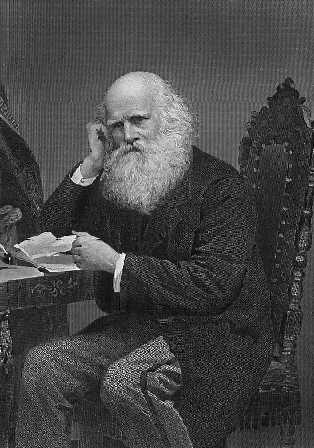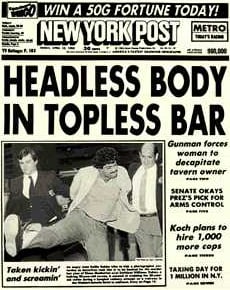New York Post

New York Post

 Front page of February 8, 2019, with the headline story reporting on the Jeff Bezos National Enquirer extortion allegations. | |
| Type | Daily newspaper |
|---|---|
| Format | Tabloid |
| Owner(s) | News Corp |
| Editor | Stephen Lynch |
| Sports editor | Christopher Shaw |
| Founded | November 16, 1801 (1801-11-16)(as New-York Evening Post) |
| Political alignment | Right-wing,[1] right-wing populism[2] |
| Language | English |
| Headquarters | 1211 Avenue of the Americas New York City 10036 United States |
| Country | United States |
| Circulation | 230,634 daily[3] |
| ISSN | 1090-3321 [97] |
| Website | nypost.com [98]pagesix.com [99] |
| |
The New York Post (sometimes abbreviated as NY Post) is a daily newspaper in New York City. The Post also operates the celebrity gossip site PageSix.com, the entertainment site Decider.com, and co-produces the television show Page Six TV.
The modern version of the paper is published in tabloid format. Established in 1801 by Federalist and Founding Father Alexander Hamilton, it became a respected broadsheet in the 19th century, under the name New York Evening Post.
In 1976, Rupert Murdoch bought the Post for US$30.5 million.[4] Since 1993, the Post has been owned by News Corporation and its successor, News Corp, which had owned it previously from 1976 to 1988. Its editorial offices are located at 1211 Avenue of the Americas (Sixth Avenue). Its distribution ranked 4th in the US in 2018.[5]
 Front page of February 8, 2019, with the headline story reporting on the Jeff Bezos National Enquirer extortion allegations. | |
| Type | Daily newspaper |
|---|---|
| Format | Tabloid |
| Owner(s) | News Corp |
| Editor | Stephen Lynch |
| Sports editor | Christopher Shaw |
| Founded | November 16, 1801 (1801-11-16)(as New-York Evening Post) |
| Political alignment | Right-wing,[1] right-wing populism[2] |
| Language | English |
| Headquarters | 1211 Avenue of the Americas New York City 10036 United States |
| Country | United States |
| Circulation | 230,634 daily[3] |
| ISSN | 1090-3321 [97] |
| Website | nypost.com [98]pagesix.com [99] |
| |
History
The New York Post, established on November 16, 1801, as the New-York Evening Post, describes itself as the nation's oldest continuously published daily newspaper. The Providence Journal, which began daily publication on July 21, 1829, also bills itself as the nation's oldest continuously published daily newspaper because the New York Post halted publication during strikes in 1958 and 1978.[6] The Hartford Courant, believed to be the oldest continuously published newspaper, was founded in 1764 as a semi-weekly paper; it did not publish daily until 1836. The New Hampshire Gazette, which has trademarked its claim of being The Nation's Oldest Newspaper, was founded in 1756 as a weekly. Since the 1890s it has been published only on weekends.
19th century

Alexander Hamilton founded the Post in 1801

William Cullen Bryant, the Post's most famous 19th-century editor
The Post was founded by Alexander Hamilton with about US$10,000 from a group of investors in the autumn of 1801 as the New-York Evening Post,[7] a broadsheet. Hamilton's co-investors included other New York members of the Federalist Party, such as Robert Troup and Oliver Wolcott,[8] who were dismayed by the election of Thomas Jefferson as U.S. President and the rise in popularity of the Democratic-Republican Party.[9] The meeting at which Hamilton first recruited investors for the new paper took place in the then-country weekend villa that is now Gracie Mansion.[10] Hamilton chose William Coleman as his first editor.[9]
In the summer of 1829, Bryant invited William Leggett, the Locofoco Democrat, to write for the paper. There, in addition to literary and drama reviews, Leggett began to write political editorials. Leggett's classical liberal philosophy entailed a fierce opposition to central banking, a support for voluntary labor unions, and a dedication to laissez-faire economics. He was a member of the Equal Rights Party. Leggett became a co-owner and editor at the Post in 1831, eventually working as sole editor of the newspaper while Bryant traveled in Europe in 1834 through 1835.
Another co-owner of the paper was John Bigelow.[13] Born in Malden-on-Hudson, New York, John Bigelow, Sr. graduated in 1835 from Union College, where he was a member of the Sigma Phi Society and the Philomathean Society,[14] and was admitted to the bar in 1838.[13] From 1849 to 1861, he was one of the editors and co-owners of the Evening Post.[13]
In 1881 Henry Villard took control of the Evening Post, as well as The Nation, which became the Post's weekly edition. With this acquisition, the paper was managed by the triumvirate of Carl Schurz, Horace White, and Edwin L. Godkin.[15] When Schurz left the paper in 1883, Godkin became editor-in-chief.[16] White became editor-in-chief in 1899, and remained in that role until his retirement in 1903.[17][18]
In 1897, both publications passed to the management of Villard's son, Oswald Garrison Villard,[19] a founding member of both the National Association for the Advancement of Colored People[20] and the American Civil Liberties Union.[21]
1918 to 1976
Villard sold the paper in 1918, after widespread allegations of pro-German sympathies during World War I hurt its circulation. The new owner was Thomas Lamont, a senior partner in the Wall Street firm of J.P. Morgan & Co.. Unable to stem the paper's financial losses, he sold it to a consortium of 34 financial and reform political leaders, headed by Edwin Francis Gay, dean of the Harvard Business School, whose members included Franklin Delano Roosevelt. Conservative Cyrus H. K. Curtis[22]—publisher of the Ladies Home Journal—purchased the Evening Post in 1924[23] and briefly turned it into a non-sensational tabloid in 1933.[23]
In 1939, Dorothy Schiff purchased the paper. Her husband, George Backer, was named editor and publisher.[25] Her second editor (and third husband) Ted Thackrey became co-publisher and co-editor with Schiff in 1942.[26] Together, they recast the newspaper into its current tabloid format.[27] In 1948 The Bronx Home News merged with it.[28] In 1949, James Wechsler became editor of the paper, running both the news and the editorial pages. In 1961, he turned over the news section to Paul Sann and stayed on as editorial page editor until 1980.
Under Schiff's tenure the Post was devoted to liberalism, supporting trade unions and social welfare, and featured some of the most popular columnists of the time, such as Joseph Cookman, Drew Pearson, Eleanor Roosevelt, Max Lerner, Murray Kempton, Pete Hamill, and Eric Sevareid, in addition to theatre critic Richard Watts, Jr. and gossip columnist Earl Wilson.
Murdoch ownership
In November 1976, it was announced that Rupert Murdoch had bought the Post from Schiff with the intention she would remain as a consultant for five years.[29] It later emerged that Murdoch bought the newspaper for US$30.5 million.[4] The Post at this point was the only surviving afternoon daily in New York City and its circulation under Schiff had grown by two-thirds, particularly after the failure of the competing World Journal Tribune. However, the rising cost of operating an afternoon daily in a city with worsening daytime traffic congestion, combined with mounting competition from expanded local radio and TV news cut into the Post's profitability, though it made money from 1949 until Schiff's final year of ownership, when it lost $500,000. The paper has lost money ever since.[9]
In late October 1995, the Post announced plans to change its Monday through Saturday publication schedule and begin issuing a Sunday edition,[30] which it last published briefly in 1989.[31] On April 14, 1996, the Post delivered its new Sunday edition at the cost of 50 cents per paper by keeping its size to 120 pages.[32] The amount, significantly less than Sunday editions from The Daily News and The New York Times, was part of Post's efforts "to find a niche in the nation's most competitive newspaper market".[32]
In December 2012, Murdoch announced that Jesse Angelo had been appointed publisher.[33]
Style

One of the paper's most famous headlines, from the edition of April 15, 1983
Murdoch imported the tabloid journalism style of many of his Australian and British newspapers, such as The Sun, which remains the highest selling daily newspaper in the UK. This style was typified by the Post's famous headlines such as "Headless body in topless bar" (shown on the right, written by Vincent Musetto). In its 35th-anniversary edition, New York magazine listed this as one of the greatest headlines. It also has five other Post headlines in its "Greatest Tabloid Headlines" list.[34]
Because of the institution of federal regulations limiting media cross-ownership after Murdoch's purchase of WNEW-TV (now WNYW) and four other stations from Metromedia to launch the Fox Broadcasting Company, Murdoch was forced to sell the paper for $37.6 million in 1988 to Peter S. Kalikow, a real-estate magnate with no news experience.[35] In 1988, the Post hired Jane Amsterdam, founding editor of Manhattan, inc., as its first female editor, and within six months the paper had toned down the sensationalist headlines.[36] Within a year, Amsterdam was forced out by Kalikow, who reportedly told her "credible doesn't sell ... Your big scoops are great, but they don't sell more papers." [37]
When Kalikow declared bankruptcy in 1993,[35] the paper was temporarily managed by Steven Hoffenberg,[35] a financier who later pleaded guilty to securities fraud;[38] and, for two weeks, by Abe Hirschfeld,[39] who made his fortune building parking garages. After a staff revolt against the Hoffenberg-Hirschfeld partnership—which included publication of an issue whose front page featured the iconic masthead picture of founder Alexander Hamilton with a single tear drop running down his cheek[40][41]—the Post was again purchased in 1993 by Murdoch's News Corporation. This came about after numerous political officials, including Democratic governor of New York Mario Cuomo, persuaded the Federal Communications Commission to grant Murdoch a permanent waiver from the cross-ownership rules that had forced him to sell the paper five years earlier.[42] Without that FCC ruling, the paper would have shut down.
Various branches of Murdoch's media groups, 21st Century Fox's Endemol Shine North America and News Corp' New York Post created a Page Six TV nightly gossip show based and named after the Post's gossip section. A test run in July would occur on Fox Television Stations.[43] The show garnered the highest ratings of a nationally syndicated entertainment newsmagazine in a decade when it debuted in 2017.[44] With *Page Six TV'*s success, the New York Post formed New York Post Entertainment, a scripted and unscripted television entertainment division, in July 2018 with Troy Searer as president.[45]
Criticism
The Post has been criticized since the beginning of Murdoch's ownership for sensationalism, blatant advocacy, and conservative bias. In 1980, the Columbia Journalism Review stated "New York Post is no longer merely a journalistic problem. It is a social problem – a force for evil."[46]
Perhaps the most serious allegation against the Post is that it is willing to contort its news coverage to suit Murdoch's business needs, in particular that the paper has avoided reporting anything that is unflattering to the government of the People's Republic of China, where Murdoch has invested heavily in satellite television.[47]
In The New Yorker, Ken Auletta writes that Murdoch "doesn’t hesitate to use the Post to belittle his business opponents". He goes on to say that Murdoch's support for Edward I. Koch while he was running for mayor of New York "spilled over onto the news pages of the Post, with the paper regularly publishing glowing stories about Koch and sometimes savage accounts of his four primary opponents."[48]
According to The New York Times, Ronald Reagan's campaign team credited Murdoch and the Post for his victory in New York in the 1980 United States presidential election.[49] Reagan later "waived a prohibition against owning a television station and a newspaper in the same market," allowing Murdoch to continue to control The New York Post and The Boston Herald while expanding into television.
Critics say that the Post allows its editorial positions to shape its story selection and news coverage. Former Post executive editor Steven D. Cuozzo has responded that the Post "broke the elitist media stranglehold on the national agenda."
According to a survey conducted by Pace University in 2004, the Post was rated the least-credible major news outlet in New York, and the only news outlet to receive more responses calling it "not credible" than credible (44% not credible to 39% credible).[50]
The Public Enemy song "A Letter to the New York Post" from their album Apocalypse '91...The Enemy Strikes Black is a complaint about what they believed to be negative and inaccurate coverage blacks received from the paper.
The Post's coverage of the murder of Hasidic landlord Menachem Stark prompted outrage from Jewish communal leaders and public figures.[51]
Controversies
There have been numerous controversies surrounding the Post:
In 1997, a national news story concerning Rebecca Sealfon's victory in the Scripps National Spelling Bee circulated. Sealfon was sponsored by the Daily News, a direct in-market competitor. Post published a picture of her but altered the photograph to remove the name of the Daily News as printed on a placard she was wearing.[52]
On March 10, 2004, Post re-ran, as a full-color page-one photograph,[53] a photograph that had already been run three days earlier in black and white on page 9, showing the 24-story suicide plunge of a New York University student, who had since been identified as 19-year-old Diana Chien, daughter of a prominent Silicon Valley businessman. Among criticisms leveled at Post[54] was their addition of a tightly cropped inset photograph of Chien, a former high-school track athlete, depicting her in mid-jump from an athletic meet, giving the false impression that it was taken during her fatal act, although she had fallen face up.
On April 21, 2006, several Asian-American advocacy groups protested the use of the headline "Wok This Way" for a Post article about Bush's meeting with the Hu Jintao, President of the People's Republic of China.[55]
On September 29, 2006, Post editor Sarah Polonsky was fired abruptly for accepting gifts.[56][57]
On December 7, 2006, Post doctored a front-page photograph to depict the co-chairmen of the Iraq Study Group—James Baker and Lee Hamilton—in primate fur, under the headline "SURRENDER MONKEYS", inspired by a once-used line from The Simpsons. In defense of the "Surrender Monkeys" headline, media contributor Simon Dumenco wrote an Ad Age article about his love for Post.[58]
On February 18, 2009, Post ran a cartoon by Sean Delonas that depicted a white police officer saying to another white police officer who has just shot a chimpanzee on the street: "They'll have to find someone else to write the next stimulus bill." The cartoon dually referred to President Obama and to the recent rampage of Travis, a former chimpanzee actor; it was criticized as being in bad taste, primarily by making a reference to the racist stereotype of African-Americans being portrayed as apes.[59] Civil rights activist Al Sharpton called the cartoon "troubling at best given the historic racist attacks of African-Americans as being synonymous with monkeys."[60] Post has defended itself by stating that the cartoon was deliberately misinterpreted by its critics.[61]
On December 4, 2012, Post used a picture taken by a freelance photographer, R. Umar Abbasi, of a 58-year-old man identified as Ki Suk Han struggling to climb back up onto the platform of the 49th Street station as a subway train approached. The caption on the front read, "Pushed on the subway track, this man is about to die" on top, and "DOOMED" in large, boldface print on the bottom. The image caused outrage among many, as its use was viewed as exploiting a tragedy for commercial gain, though Abbasi stated that since he was not strong enough to pull the man up, he had attempted to use the flash on his camera to alert the driver of the oncoming train.[62] This was used as inspiration for the 2014 musical Ghost Quartet.
Aspects of Post's coverage of the 2013 Boston Marathon bombing were criticized. Post reported in several stories on the day of the attack that the death toll was 12, while most organizations reported two and then three fatalities. In addition, they reported that a Saudi national was being held as a suspect, but Boston Police denied this and said they had no suspects in custody.[63] Additionally, the April 18 cover of Post featured a full-page photo of two young men the paper described as being sought by law enforcement in possible connection with the attack. CBS News reporter John Miller reported that the two men are not considered suspects by the FBI. The apparent insinuation by Post that they were suspects was denounced by media critics.[64] In June 2013, the two men, Salaheddin Barhoum and Yassine Zaimi, sued Post for libel over the story.[65] In 2014, the suit was settled.[66][67]
On April 11, 2019, Post displayed an image of the World Trade Center in flames targeting Rep. Ilhan Omar, one of the first two Muslim women to serve in Congress and a target of the right wing since her election. A partial quote by Representative Omar, criticized in conservative circles, was included.[68] The influential Yemeni American Merchant Association announced a formal boycott of the paper and ten of the most prominent Yemeni bodega owners in New York agreed to stop selling the paper. As of June 2019, the boycott had extended to over 900 individual stores.[69] Yemini-Americans own about half of the 10,000 bodegas in New York City.[70]
The Post and the Daily News often take potshots at each other's work and accuracy, particularly in their respective gossip-page items.
Influence
In 2017, the New York Post was reported to be the preferred newspaper of U.S. President Donald Trump,[73][74] who maintains frequent contact with its owner, Rupert Murdoch.[74]
Operations
Website

Printing plant
In 1996, the New York Post launched an Internet version of the paper. The original site included color photos and sections broken down into News, Sports, Editorial, Gossip, Entertainment and Business. It also had an archive for the past seven days. Since then, it has been redesigned a number of times, with the latest incarnation launched in September 2013.[75][76]
The current website also features continually updated breaking news; opinion, entertainment, business, tech, media, fashion and sports content; photo and video galleries; original Post videos; and streaming video for live events.
In 2014, the Post launched the website Decider. Decider provides recommendation for streaming services.[77]
Highlights
The paper is well known for its sports section, which has been praised for its comprehensiveness; it begins on the back page, and among other coverage, contains columns about sports in the media by Phil Mushnick.
New York Post is also well known for its gossip columnist Cindy Adams.
Page Six
The gossip section "Page Six" was created by James Brady[78] and currently edited by Emily Smith (although it no longer actually appears on page six of the tabloid). Columnist Richard Johnson edited Page Six for 25 years.[79] February 2006 saw the debut of Page Six Magazine, distributed free inside the paper. In September 2007, it started to be distributed weekly in the Sunday edition of the paper. In January 2009, publication of Page Six Magazine was cut to four times a year. Daily web content is published at www.pagesix.com.
Beginning with the 2017–18 television season, a daily syndicated series known as Page Six TV came to air, produced by 20th Television, which was part of the 21st Century Fox side of Rupert Murdoch's holdings, and Endemol Shine North America. The show is hosted by comedian John Fugelsang, with contributions from Page Six and Post writers (including Carlos Greer), along with regular panelists Elizabeth Wagmeister from Variety and Bevy Smith. In March 2018, Fugelsang left and Page Six TV announced it was looking for a new host. Later it was announced that Wagmeister, Greer and Smith would be retained as equal co-hosts.[80]
In April 2019, it was reported that the series would not be renewed for a third season; by then, it was last in average viewership out of all U.S. syndicated newsmagazine programs, behind the similar tabloid-inspired program Daily Mail TV.[81]
Sales
The daily circulation of Post decreased in the final years of the Schiff era from 700,000 in the late 1960s to approximately 418,000 by the time she sold the paper to Murdoch in 1976. Under Murdoch, Post launched a morning edition to compete directly with the rival tabloid Daily News in 1978—prompting the Daily News to retaliate with a PM edition called Daily News Tonight. But the PM edition suffered the same problems with worsening daytime traffic that the afternoon Post experienced and the Daily News ultimately folded Tonight in 1981. By that time, circulation of the all-day Post soared to a peak of 962,000, the bulk of the increase attributed to its morning edition (It set a single-day record of 1.1 million on August 11, 1977 with the news of the arrest the night before of David Berkowitz, the infamous "Son of Sam" serial killer who terrorized New York for much of that summer). But Post lost so much money that Murdoch decided to shut down Post's PM edition in 1982, turning Post into a morning-only daily.
Post and the Daily News have been locked in a bitter circulation war ever since. A resurgence during the first decade of the 21st century saw Post circulation rise to 724,748 by April 2007,[3] achieved partly by lowering the price from 50 cents to 25 cents. In October 2006, Post for the first time surpassed the Daily News in circulation—only to see the Daily News overtake its rival a few months later.[82] In 2010, the Post's daily circulation was 525,004, just 10,000 behind the Daily News.[83] As of 2017, the Post was the fourth-largest newspaper in the United States by circulation, while the Daily News was ranked eighth.[84]
Yet Post has remained unprofitable since Murdoch first purchased it from Dorothy Schiff in 1976—and was on the brink of folding when Murdoch bought it back in 1993, with at least one media report in 2012 indicating that Post loses up to $70 million a year.[85] One commentator has suggested that Post cannot become profitable as long as the competing Daily News survives, and that Murdoch may be trying to force the Daily News to fold or sell out, leaving the two papers in an intractable war of attrition.[86]
Union
The Newspaper and Mail Deliverers Union has been delivering this newspaper "since the early 1900s."[87]
Recent headquarters
The 1906 Old New York Evening Post Building is a designated landmark. It was added to the National Register of Historic Places in 1977.[88] It occupied the building until 1926 when a new main office for the Post was established at 75 West Street in the New York Evening Post Building. The building remained in use by the Post until 1970, it was added to the National Register of Historic Places in 2000.[88] In 1967, Schiff bought 210 South Street, the former headquarters of the New York Journal American, which closed a year earlier. The building became an instantly recognizable symbol for the Post. In 1995, owner Rupert Murdoch relocated Post's news and business offices to the News Corporation headquarters tower at 1211 Avenue of the Americas (Sixth Avenue) in midtown Manhattan. Post shares this building with Fox News Channel and The Wall Street Journal, both of which are also owned by Murdoch. Both the Post and the New York City edition of the Journal are printed at a state-of-the-art printing plant in the borough of The Bronx.
Cultural references
Vincent Musetto's 1983 headline inspired Peter Koper to write the 1995 American black comedy Headless Body in Topless Bar.[89] Post front-page headlines have been featured in such films as The Manchurian Candidate, North by Northwest, Working Girl, Who Was That Lady?, and Top Secret!.
See also
Media in New York City